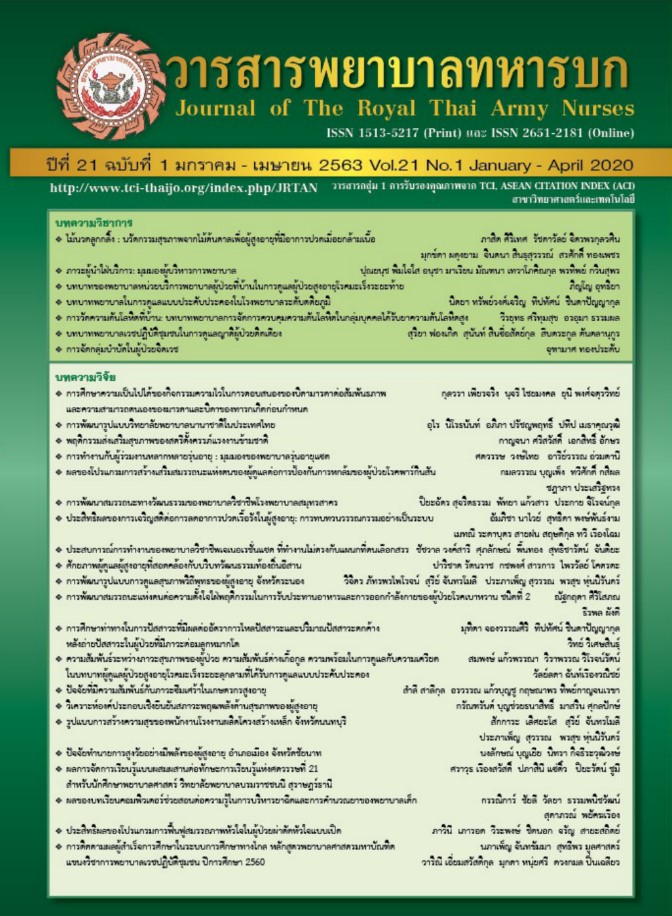Happiness Promotion Model for Steel Factory Employees in Nonthaburi Province
Keywords:
รูปแบบการสร้างความสุข, พนักงาน, โรงงานผลิตโครงสร้างเหล็กAbstract
The purpose of this research and development study was to study the happiness promotion model for steel factory employees in Nonthaburi Province. There were 3 phases in research procedure including 1) context analysis, 2) developmental and trial and 3) evaluation phases. The sample consisted of 48 employees.The data were collected by questionnaires and happy quiz five expert’s quality reviews. The data were analyzed and described by using percentage, mean, standard deviation. dependent t- test. and content analysis
The research found that steel factory employees were happy to work, and employees had relationship and bond with the organization at medium level. The research was applied the theory and concept of creating happiness, attachment concept, theories of Maslow and forms of employee happiness. There are six elements of happiness: 1) good health, happiness 2) kindness, happiness 3) debt-free, happiness 4) relaxation, happiness 5) knowledge, happiness and 6 ) Good social aspects create happiness Proceed with the activity program The employees who participated in the happiness building program had an average knowledge after the experiment was higher than before the experiment (t = 1.56; p-value <.05). After the experiment was higher than before the experiment (t = 5.81; p-value <.05), the results showed that the post-experimental happiness program was at a high level ( = 4.09) and the results of the post-happiness building program 2 months experiment showed that it was at a high level (
= 4.08)
Downloads
References
2. Maslow, Harold A. Motivation and Personality. New York: Harper & Row; 1954.
3. Leerang S. The relationship between the five personality traits awareness of use the power of the supervisor and employee happiness: case study of employees a hotel in bangkok. Personal research, Master’s degree, Thammasat University, Faculty of Arts, Industrial and Organizational Psychology; 2010. (in Thai)
4. Ketkaew P. Relationship between perception of job characteristics, ability to face and overcome obstacles with nursing work happiness Surgical Nursing Jobs: A case study of a Public Hospital. Personal research, Master’s Degree, Thammasat University, Faculty of Art Science, Industrial and
Organizational Psychology; 2008. (in Thai)
5. Sudwilai S. The study of the relationship between self-efficacy the ability to face and dream through obstacles And work stress of employees in a private company. Personal research, Master’s degree, Thammasat University, Faculty of Arts, Industrial and Organizational Psychology; 2007. (in Thai)
6. Jitthaphan N. Personal factors, happiness in work and organizational commitment of employees: A case study of a food manufacturing factory.
Master of arts thesis. Department of Industrial and Organizational psychology department of psychology. College Thammasat University; 2011. (in Thai)
7. Itthiwarakorn R. Relationship between spiritual intelligence happiness in work and intention to resign: a case study of a private company in bangkok personal research, Master’s degree, Thammasat University, Faculty of arts, Industrial and organizational psychology; 2009. (in Thai)
8. Boonlom W. The relationship between quality of work life Commitment organization and good membership behavior of the organization of teacher civil servants Technical College in the three southern border provinces. Master of Science degree, Department of Industrial and Organizational Psychology, Chiang Mai University; 2008. (in Thai)
9. Thanarat C. 123 to become a happy organization. Nonthaburi, two legs, creation; 2008. (in Thai)
10. Pinthong S. Sports management model of Thailand to be a happy organization. Doctor of Philosophy Dissertation (Sports Science): Graduate School Kasetsart University; 2008. (in Thai)
11. Thepnarin N, Buapetch A and Isaramalai S. The effect of health belief model and risk management program for heat injury prevention among the Royal Thai Army Recruits. Journal of The Royal Thai Army Nurse 2018; 19 (1): 115-125. (in Thai)
12. Chunthai K, Haruthai C, Sathira-angura T. Model development of chief nursing officer’s network for health promotion. Journal of The Royal
Thai Army Nurse 2018; 19 (1): 241-252. (in Thai)
Downloads
Published
How to Cite
Issue
Section
License
บทความหรือข้อคิดเห็นใดใดที่ปรากฏในวารสารพยาบาลทหารบกเป็นวรรณกรรมของผู้เขียน ซึ่งบรรณาธิการหรือสมาคมพยาบาลทหารบก ไม่จำเป็นต้องเห็นด้วย
บทความที่ได้รับการตีพิมพ์เป็นลิขสิทธิ์ของวารสารพยาบาลทหารบก
The ideas and opinions expressed in the Journal of The Royal Thai Army Nurses are those of the authors and not necessarily those
of the editor or Royal Thai Army Nurses Association.






